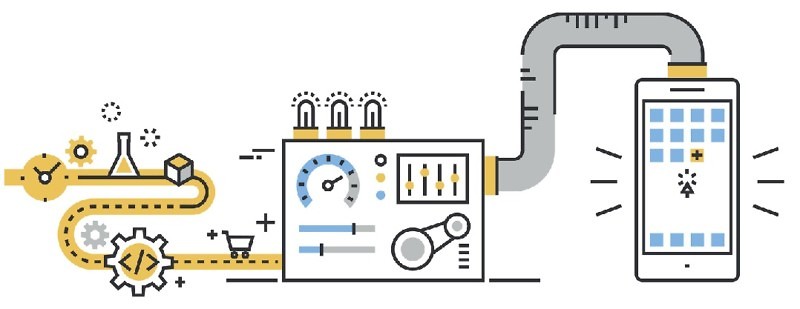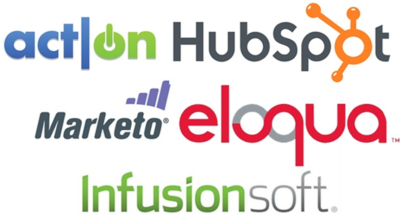
I like to think of inbound marketing as a lead generation machine. When it’s given proper maintenance and all the parts are working together, you can expect consistent web traffic growth and delivery of leads. But like any other machine, if you remove one part, it can’t deliver at a peak performance level and may quit working altogether. You must have all the parts in place and working together for it to be successful. Here are a few of the different “parts” or components of inbound marketing that you have to have for your program to work, and best practices for their usage.
Inbound Marketing Software
Like a computer needs a motherboard, your inbound marketing program need a foundation to reside on. This will require an investment in a third party inbound marketing platform. There are many inbound platforms available today, among the most popular ones being HubSpot, Act-On, Marketo, Infusionsoft, Pardot,  and Optify. Each platform has similar functionality and options, with pricing ranging from $300 to $6,500 per month. You need this software because as you create the content, post on social media, and deliver emails, you need to be able to have a way to collect the information as people interact and are nurturedthrough the sales “funnel”, and also interpret the data so you are continually optimizing for success and a better ROI. The most important features of an inbound system are providing a content/blogging platform, SEO tools, email targeting, automation, segmentation and delivery, landing page and form creation, lead scoring and robust reporting delivery.
and Optify. Each platform has similar functionality and options, with pricing ranging from $300 to $6,500 per month. You need this software because as you create the content, post on social media, and deliver emails, you need to be able to have a way to collect the information as people interact and are nurturedthrough the sales “funnel”, and also interpret the data so you are continually optimizing for success and a better ROI. The most important features of an inbound system are providing a content/blogging platform, SEO tools, email targeting, automation, segmentation and delivery, landing page and form creation, lead scoring and robust reporting delivery.
Persona Creation
Inbound marketing begins and ends with personas, or someone you have identified as the most likely candidate to convert to a customer. You need to know exactly who it is you want to talk to, provide solutions for, and convert into a customer for inbound to work successfully. Everything done from this point on is with these personas in mind, whether it’s content creation, language used for a call-to-action, or which social media channels to use. A great tool to help with the creation of personas is a worksheet allowing you to give a detailed description of each persona, such as their work title, role, challenges, channels of communication and current lead sources. HubSpot has an online persona creation tool called MakeMyPersona that will create personas from data you enter.
Content
They say “content is king” and that’s especially true for a successful inbound campaign. Content plays a vital role, if not the most important role, because it’s what your potential customers are seeking for solutions and answers. And because of the current Google algorithms, good content with proper SEO is rewarded with high rankings so your potential customers can find this information. Inbound marketing content can come in many forms, including website copy, blog posts, ebooks, white papers, videos, e-newsletters, podcasts and infographics. Each piece of content is optimized with keywords and phrases that will help rank higher for searches. For instance, let’s say one of your personas is a bank owner, and you know one of the challenges of this particular persona is regulatory compliance. So you write a blog about how to keep up with the escalating regulatory requirements in the banking industry. Within the title and URL of the blog are the words “regulatory requirements” or “banking regulations”. Whatever keyword or phrase that has the highest search results (which you can find out with different tools, such as Goolge Keyword Planner). This will help when the person you want to reach searches using these keywords, and thus finds your content. The same is true for any other content you create.
[cmsmasters_row data_width=”fullwidth” data_padding_left=”2″ data_padding_right=”2″ data_top_style=”default” data_bot_style=”default” data_color=”second” data_bg_color=”#cf212f” data_padding_top=”20″ data_padding_bottom=”20″ data_classes=”bg-img-np”][cmsmasters_column data_width=”1/4″][cmsmasters_image align=”none” animation_delay=”0″]7795|https://gonextpage.com/wp-content/uploads/2016/12/inbound-ebook-cover-edited-e1491580772563.png|full[/cmsmasters_image][/cmsmasters_column][cmsmasters_column data_width=”3/4″][cmsmasters_heading type=”h1″ font_family=”Open+Sans:300,300italic,400,400italic,700,700italic” font_size=”28″ font_weight=”400″ font_style=”normal” text_align=”left” color=”#ffffff” margin_top=”0″ margin_bottom=”10″ animation_delay=”0″]Are you frustrated with never being able to get in touch with a sales lead?[/cmsmasters_heading][cmsmasters_text animation_delay=”0″]Find out how inbound marketing will deliver the qualified leads right to your inbox with this free ebook.[/cmsmasters_text][cmsmasters_button button_link=”https://go.pardot.com/l/891523/2020-11-17/dml” button_target=”blank” button_text_align=”left” button_font_weight=”normal” button_font_style=”normal” button_border_style=”solid” button_bg_color=”#3b8dc1″ button_text_color=”#ffffff” button_border_color=”#518ff5″ button_bg_color_h=”#ffffff” button_text_color_h=”#518ff5″ button_border_color_h=”#518ff5″ animation_delay=”0″]Download Now[/cmsmasters_button][/cmsmasters_column][/cmsmasters_row][cmsmasters_row data_padding_bottom=”0″ data_padding_top=”0″ data_bg_color=”#ffffff” data_color=”default” data_bot_style=”default” data_top_style=”default” data_no_margin=”true” data_padding_right=”0″ data_padding_left=”0″ data_width=”fullwidth”][cmsmasters_column data_width=”1/1″]
Social Media
The social media landscape is always evolving, and it’s importance to lead generation cannot be understated. Facebook continues to be the social media king, with over 1.79 billion users, followed by YouTube, Twitter, Linkedin, Pinterest, Google Plus, Tumblr, and Instagram. Social media plays a key role with inbound. You need it to promote content you’ve created like a blog or ebook, it’s a great tool to get a better understanding of your audience, it will help you rank higher in Google searches, and it’s a great way to promote and enhance your brand. The channel you use should speak to your personas, and the content you post should be relevant to the channel. For example Linkedin is good for industry specific or business news, Facebook should reflect your services and culture, Twitter is good for just about anything, and use Instagram if your product translates well visually. Always test which posts get the better results, so you can modify your strategy.
Offers and Landing Pages
So you have this great new ebook that will help attract personas to your website. Now what? The whole idea behind inbound isn’t just the attraction, it’s the conversion of visitors into leads. Get them into the sales funnel and nurture them through to a customer. To do that you need to give the visitor an incentive so you can obtain their information. Offers are categorized three different ways: top, middle and bottom of the funnel. A top of the funnel offer is used when the lead knows they have an issue or question, but need to be educated more. They don’t know if you can provide the answer, but they’re willing to give you their name and email in exchange for something that may help them understand. An ebook, whitepaper or a video is a good example of a top of the funnel offer. Middle of the funnel offers are for leads that are educated on their problem and are now searching for the solution. Good offers for middle of the funnel include webinars, product samples, or case studies. Finally, the bottom of the funnel lead is educated on their problem, they know the solution, and they know you can provide it. The offer associated with a bottom of the funnel lead is usually a free consultation or free trial. This is a sales qualified lead comfortable with you and what you offer and is ready to be converted to a customer. All of these offers are introduced to the lead via a call-to-action or CTA. A CTA is strategically placed on a web page or in content, when the lead is ready to move on and be further nurtured in the sales funnel. Using our previous bank owner example, the blog about how to best handle banking regulations in 2017, there’s a CTA providing an opportunity to download a free ebook. It will go into further detail on best practices for handling banking regulatory requirements (which is something your company does for banks as a service). The banker clicks the CTA, and then is delivered to a landing page and form to fill out. This form asks for his name and email address, and in exchange he is delivered the ebook. He is then delivered an email after a period of time asking him about the ebook and if he would like to attend a webinar (middle of the funnel) or perhaps speak with a customer representative (bottom of the funnel). If he clicks on this CTA, he’s delivered to another landing page, with a form that asks for more information, and an email is sent to a sales rep to follow up with this lead. Keep in mind, the journey through the sales funnel is rarely this easy. Many times the lead goes back and reads more blogs, maybe downloads another ebook, or perhaps doesn’t convert to the bottom of the funnel for 6 months.
Email Workflows
The challenge for many sales representatives is the follow up and continual contact necessary to follow a lead through to a signed customer. According to MarketingDonut, 80% of sales require 5 follow-up calls after the meeting, and 44% of sales reps give up after 1 follow up. With inbound, the loop is always closed; workflows will continue to nurture the lead with emails until they either convert and are delivered to your CRM, or opt out. Most inbound platforms will provide workflows or automated programs that will make sure the right leads are delivered emails at the right time. For instance, you may want to set up a workflow to deliver an email automatically to a lead that has turned into a bottom of the funnel lead based on a lead scoring designation. And then they are sent monthly emails to continue to deliver meaningful content to them until they convert or opt out. All these emails can and should be personalized to the person receiving them.
So to summarize, content is created to attract visitors (your personas) to your website, CTA’s, landing pages and forms convert the visitors to leads, the CRM, emails and workflows close the leads into customers, and surveys, smart content and social monitoring delight customers into promoters of your business. Inbound marketing is not a difficult program to put in place, but it does require consistent creation of content, interpretation of data to make changes as needed, and evaluation of reporting to track performance. If you can keep your inbound machine running with all the parts in place, you will see positive lead generation results within 3 to 6 months.
You an find more helpful information on inbound marketing in the NextPage free ebook, Introduction to Inbound Marketing.
